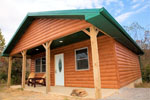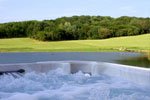FORT MASSAC STATE PARK
Experience the scenic splendor of Southern Illinois with plenty of outdoor fun and time-telling events at Fort Massac State Park. Overlooking the mighty Ohio River from the southern tip of Illinois, this majestic location has been preserved and maintained since 1908, when it became Illinois? first state park.
Today, Fort Massac is a captivating reminder of days gone by, a fascinating excursion through the entire course of American history, and the perfect place to relax in soothing natural surroundings and explore life as it was lived when our country was young.
The historic site is a replica of the 1802 American fort that was on site. The historic fort area contains 2 barracks, 3 block hourses, officer quarters, well, stockade along with a fraise fence. The site also has the archaeological outline of the 1757 French Fort. There is also a visitors center/office complex along with an area for the museum.
Actual re-creations of pioneer life of the 1700s during the annual Fort Massac Encampment and several living history weekends each year bring the past to life, letting you experience it yourself.
With all this, and the picnicking, camping, hiking, boating and hunting opportunities available in the rest of the 1,450-acre area, Fort Massac State Park is an alluring, complete and self-contained family vacation spot.
The rich history of this site begins before recorded history, when native Americans undoubtedly took advantage of its strategic location overlooking the Ohio River. Legend has it that Europeans took this same advantage as early as 1540, when the Spanish explorer Hernando DeSoto and his soldiers constructed a primitive fortification here to defend themselves from hostile native attack.
The French built Fort De L?Ascension on the site in 1757, during the French and Indian War, when France and Great Britain were fighting for ultimate control of central North America. Rebuilt in 1759-60, the structure was renamed Massiac in honor of the then French Minister of Colonial Affairs, and came under fire only once, when unsuccessfully attacked by a group of Cherokee.
Following the end of the French and Indian War in 1763, the French abandoned the fort and a band of Chickasaws burned it to the ground. When Captain Thomas Stirling, commander of the 42nd Royal Highland Regiment, arrived to take possession, all he found was a charred ruin.
The British anglicized the name to ?Massac? but, despite the counsel of their military advisers, they neither rebuilt nor regarrisoned the fort. This oversight left them vulnerable and in 1778, during the Revolutionary War, Colonel George Rogers Clark led his ?Long Knives? regiment into Illinois at Massac Creek and was able to capture Kaskaskia, 100 miles to the north, without firing a shot-thus taking the entire Illinois Territory for the State of Virginia and the fledgling United States.
In 1794, President George Washington ordered the fort rebuilt, and for the next 20 years it protected U.S. military and commercial interests in the Ohio Valley.
U.S. Vice President Aaron Burr and Gen. James Wilkinson, who allegedly drew up plans to personally conquer Mexico and the American southwest, met at Fort Massac during the summer of 1805. Edward Everett Hale later used the setting of Fort Massac and the Burr-Wilkinson plot as basis for his classic historical novel, ?The Man Without a Country.?
Although ravaged by the New Madrid earthquake in 1811-12, the fort was again rebuilt in time to play a minor role in the War of 1812, only to be abandoned again in 1814. Local citizens dismantled the fort for timber, and by 1828 little remained of the original construction. In 1839 the city of Metropolis was platted about a mile west of the fort.
The site served briefly as a training camp during the early years of the Civil War, marking the last time U.S. troops were stationed at the site. The fort was abandoned after a measles epidemic in 1861-62 claimed the lives of a substantial number of soldiers of the Third Illinois Cavalry and the 131st Illinois Infantry, who were using the fort as an encampment.
In 1903, through the efforts of the Daughters of the American Revolution, 24 acres surrounding the site were purchased by the state and on Nov. 5, 1908, it was officially dedicated as Illinois? first state park.
Archeological and historical excavations were conducted on the site from 1939-42 and attempted again in 1966 , 1970, and during 2002. In the early 1970's a replica of an American fort at Fort Massac was reconstructed off the original site of the forts. The replica was based on the 1794 American Fort. This reconstruction was brought down in the fall of 2002, to rebuild another replica of a 1802 American fort. The original site, where all the forts were built has the archeological outline of the 1757 French Fort.
The historic site is open to the public seven days a week. Contact the site interpreter to arrange special programs for educational, scouting, civic or tour groups.
Day-UseFishingyes
Huntingyes
Hiking Trailyes
Swimming Beachyes
Bike Trailsyes
BoatingLaunch Rampsyes
WinterActivitiesyes
There are 50 Class A vehicular campsites with electricity, a disposal station and a shower building, tent camping, and a separate group campground.

Cottages and Cabins
LARGE 2 and 3 bedroom private CABINS located near many of the major ATTRACTIONS of the Shawnee National FOREST and the surrounding Southern ILLINOIS area. All cabins offer incredible VALUE as they are fully furnished with everything needed including full kitchens with cookware, microwave, liens, fire pits and wood, outdoor grill, satellite TV and even FREE internet. Open all seasons
19 miles from park*





